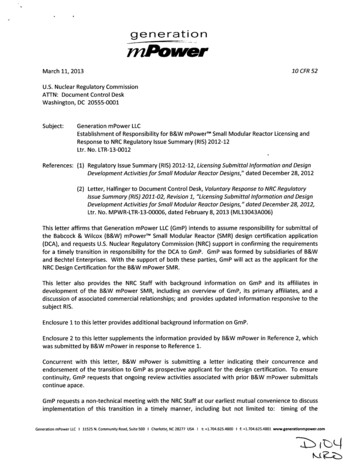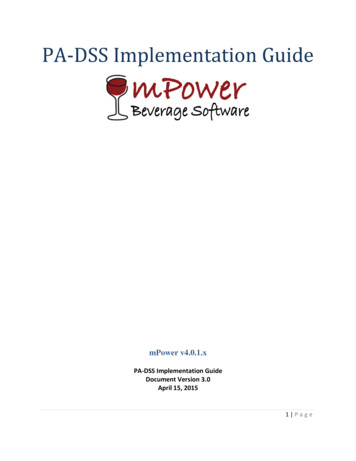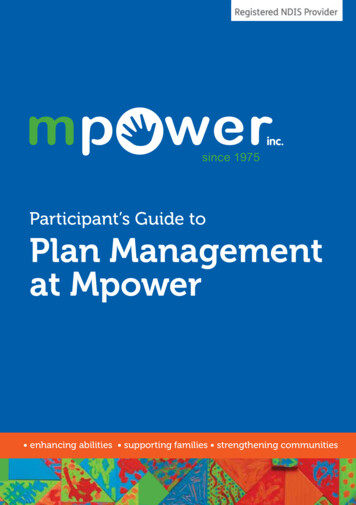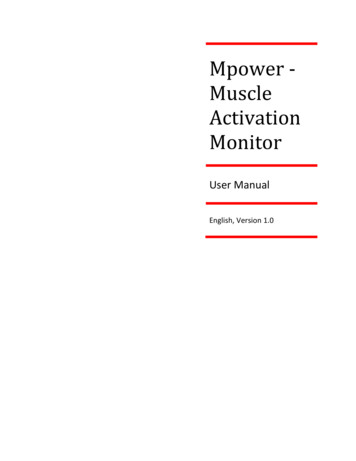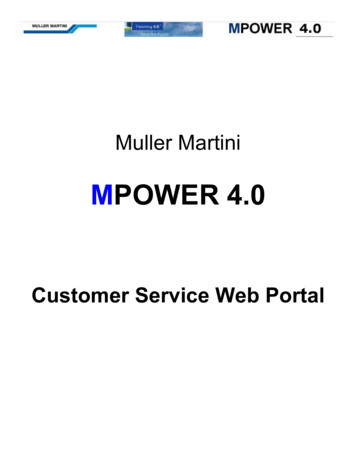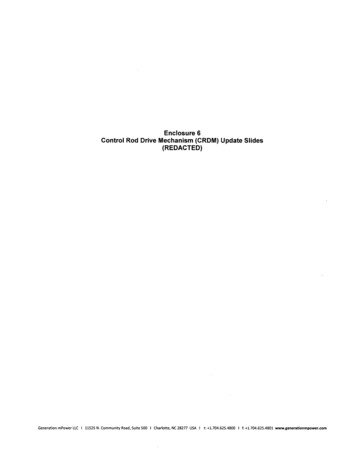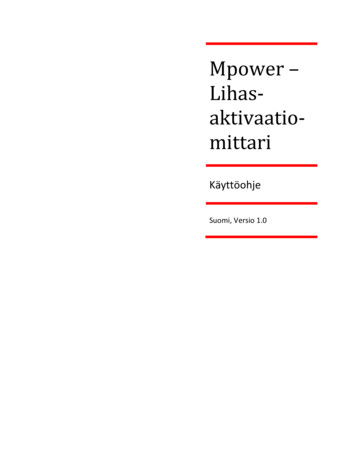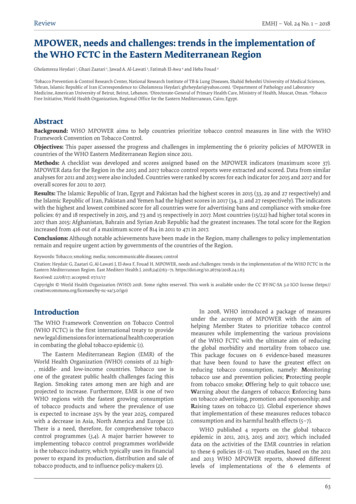
Transcription
ReviewEMHJ – Vol. 24 No. 1 – 2018MPOWER, needs and challenges: trends in the implementation ofthe WHO FCTC in the Eastern Mediterranean RegionGholamreza Heydari 1, Ghazi Zaatari 2, Jawad A. Al-Lawati 3, Fatimah El-Awa 4 and Heba Fouad 4Tobacco Prevention & Control Research Center, National Research Institute of TB & Lung Diseases, Shahid Beheshti University of Medical Sciences,Tehran, Islamic Republic of Iran (Correspondence to: Gholamreza Heydari: ghrheydari@yahoo.com). 2Department of Pathology and LaboratoryMedicine, American University of Beirut, Beirut, Lebanon. 3Directorate-General of Primary Health Care, Ministry of Health, Muscat, Oman. 4TobaccoFree Initiative, World Health Organization, Regional Office for the Eastern Mediterranean, Cairo, Egypt.1AbstractBackground: WHO MPOWER aims to help countries prioritize tobacco control measures in line with the WHOFramework Convention on Tobacco Control.Objectives: This paper assessed the progress and challenges in implementing the 6 priority policies of MPOWER incountries of the WHO Eastern Mediterranean Region since 2011.Methods: A checklist was developed and scores assigned based on the MPOWER indicators (maximum score 37).MPOWER data for the Region in the 2015 and 2017 tobacco control reports were extracted and scored. Data from similaranalyses for 2011 and 2013 were also included. Countries were ranked by scores for each indicator for 2015 and 2017 and foroverall scores for 2011 to 2017.Results: The Islamic Republic of Iran, Egypt and Pakistan had the highest scores in 2015 (33, 29 and 27 respectively) andthe Islamic Republic of Iran, Pakistan and Yemen had the highest scores in 2017 (34, 31 and 27 respectively). The indicatorswith the highest and lowest combined score for all countries were for advertising bans and compliance with smoke-freepolicies: 67 and 18 respectively in 2015, and 73 and 15 respectively in 2017. Most countries (15/22) had higher total scores in2017 than 2015: Afghanistan, Bahrain and Syrian Arab Republic had the greatest increases. The total score for the Regionincreased from 416 out of a maximum score of 814 in 2011 to 471 in 2017.Conclusions: Although notable achievements have been made in the Region, many challenges to policy implementationremain and require urgent action by governments of the countries of the Region.Keywords: Tobacco; smoking; media; noncommunicable diseases; controlCitation: Heydair G, Zaatari G, Al-Lawati J, El-Awa F, Fouad H. MPOWER, needs and challenges: trends in the implementation of the WHO FCTC in theEastern Mediterranean Region. East Mediterr Health J. 2018;24(1):63–71. https://doi.org/10.26719/2018.24.1.63Received: 22/08/17; accepted: 07/11/17Copyright World Health Organization (WHO) 2018. Some rights reserved. This work is available under the CC BY-NC-SA 3.0 IGO license /igo)IntroductionThe WHO Framework Convention on Tobacco Control(WHO FCTC) is the first international treaty to providenew legal dimensions for international health cooperationin combating the global tobacco epidemic (1).The Eastern Mediterranean Region (EMR) of theWorld Health Organization (WHO) consists of 22 high, middle- and low-income countries. Tobacco use isone of the greatest public health challenges facing thisRegion. Smoking rates among men are high and areprojected to increase. Furthermore, EMR is one of twoWHO regions with the fastest growing consumptionof tobacco products and where the prevalence of useis expected to increase 25% by the year 2025, comparedwith a decrease in Asia, North America and Europe (2).There is a need, therefore, for comprehensive tobaccocontrol programmes (3,4). A major barrier however toimplementing tobacco control programmes worldwideis the tobacco industry, which typically uses its financialpower to expand its production, distribution and sale oftobacco products, and to influence policy-makers (2).In 2008, WHO introduced a package of measuresunder the acronym of MPOWER with the aim ofhelping Member States to prioritize tobacco controlmeasures while implementing the various provisionsof the WHO FCTC with the ultimate aim of reducingthe global morbidity and mortality from tobacco use.This package focuses on 6 evidence-based measuresthat have been found to have the greatest effect onreducing tobacco consumption, namely: Monitoringtobacco use and prevention policies; Protecting peoplefrom tobacco smoke; Offering help to quit tobacco use;Warning about the dangers of tobacco; Enforcing banson tobacco advertising, promotion and sponsorship; andRaising taxes on tobacco (2). Global experience showsthat implementation of these measures reduces tobaccoconsumption and its harmful health effects (5–7).WHO published 4 reports on the global tobaccoepidemic in 2011, 2013, 2015 and 2017, which includeddata on the activities of the EMR countries in relationto these 6 policies (8–11). Two studies, based on the 2011and 2013 WHO MPOWER reports, showed differentlevels of implementations of the 6 elements of63
ReviewMPOWER (12,13). For example, the lack of adherence tothe smoking ban in public places was alarmingly high.The studies also demonstrated the poor compliance ofthe tobacco industry with tobacco control laws, and thesale of tobacco products is still almost unregulated. Thiscontrasts with the experiences in other WHO regionswhere implementation has been better than the EMR(14–16).Lessons can be learned from 10 years of implementingWHO FCTC and the demonstrated benefit in combatingnoncommunicable diseases (17,18). Cairney and Mamudu(19) report that the best approach to tobacco control in acountry requires specific policy processes, namely: thedepartment of health takes the policy lead; tobacco is‘framed’ as a public health problem; public health groupsare consulted at the expense of tobacco control interests;socioeconomic conditions are conducive to policychange; and the scientific evidence is ‘set in stone’ withingovernments. No country can meet all these requirementsin a short period and there is a wide gap between theexpectations of implementing such programmes and theactual situation in many countries, particularly in theEMR. In 2016 and 2017, 2 studies showed that the WHOFCTC implementation in the Region had not improvedgreatly over the past 6 years (20,21); countries had failed toadopt stronger and more effective policies; and reinforcethe already existing laws.Our study therefore aimed to compare the performanceof EMR countries over time in implementation ofMPOWER policies, and discuss some of the challengesEMHJ – Vol. 24 No. 1 – 2018facing the countries in adopting these effective measures.MethodsThis study was conducted during May–September2017. Published literature, official reports on MPOWERand communications with regional experts in the fieldof tobacco control were the source of our data. Tworesearchers searched and summarized the papers andreports, screened studies, extracted data independentlyand resolved any discrepancies under the supervision ofthe first author. The checklist was designed previously(12,13) by Iranian and international tobacco controlspecialists and contained 10 indicators based on the mainelements of MPOWER [Monitoring, Smoke-free policies,Cessation programmes, Warnings (health warningon cigarette packets, and mass media campaigns),Advertising bans, and Taxation], and 3 other MPOWERindicators: smoking prevalence, smoke-free policycompliance and advertising ban compliance. The cut-offswere set according to the scoring of the indicators in the2015 Report on the Global Tobacco Epidemic (8). Sevenindictors had 5 options and we assigned a score of 0 upto a maximum of 4; 3 indictors had 4 possible optionsand were assigned a score of 0 up to a maximum of 3.Higher scores indicate better level of implementation ofMPOWER policies. Thus, the maximum possible scorewas 37 (Table 1). If data were not available for an indicator,it was scored as zero. As with the two previous studies(12,13), two trained assessors conducted the assessment(correlation coefficient between them 0.8). Dataentry was done independently by the first assessor andTable 1 Matrix used to assess tobacco control in EMR countries based on the 2015 WHO MPOWER report (8)IndicatorScoreAdult daily smoking prevalence4Estimates not available0 30%120–29%215–19%3 15%4Monitoring: prevalence data3No known or recent data or data that are not both recent and representative0Recent and representative data for either adults or adolescents1Recent and representative data for both adults and adolescents2Recent, representative and periodic data for both adults and adolescents3Smoke-free policies (protecting people from second-hand smoke)4Data not reported0Up to 2 public places completely smoke free13–5 public places completely smoke free26 or 7 public places completely smoke free3All public places completely smoke free4Cessation programmes4Data not reported0None164
ReviewEMHJ – Vol. 24 No. 1 – 2018Table 1 Matrix used to assess tobacco control in EMR countries based on the 2015 WHO MPOWER report (8) continuedIndicatorScoreNicotine replacement therapy and/or some cessation services (neither cost-covered)2Nicotine replacement therapy and/or some cessation services ( 1 of which is cost-covered)3National quit line, and both nicotine replacement therapy and some cessation services cost-covered4Health warnings (on cigarette packages)4Data not reported0No warnings or small warnings1Medium-size warnings missing some appropriate characteristics2Medium-size warnings with all appropriate characteristics3Large warnings with all appropriate characteristics4Mass media warnings through anti-tobacco campaigns4Data not reported0No campaign conducted1Campaign conducted with 1–4 appropriate characteristics2Campaign conducted with 5–6 appropriate characteristics3Campaign conducted with all appropriate characteristics4Ban on tobacco advertising, promotion and sponsorship4Data not reported0Complete absence of a ban in print media1Ban on national television, radio and print media onlyBan on national television, radio and print media as well as on some but not all other forms of direct and/or indirectadvertisingBan on all forms of direct and indirect advertising24Tax on tobacco products4Data not reported0 25% of retail price is tax126–50% of retail price is tax251–75% of retail price is tax3 75% of retail price is tax4Compliance with bans on advertising3Complete compliance (8/10 to 10/10)3Moderate compliance (3/10 to 7/10)2Minimal compliance (0/10 to 2/10)1Not reported0Compliance with smoke-free policies33Complete compliance (8/10 to 10/10)3Moderate compliance (3/10 to 7/10)2Minimal compliance (0/10 to 2/10)1Not reported0Totalwas checked by the second. The principal investigatorrandomly selected 2 or 3 of the data entered to monitorthe ratings.ResultsCountries were ranked by scores for each indicator for2015 and 2017 as shown in Tables 2 and 3 respectively.The highest scores were attained by Egypt, the IslamicRepublic of Iran and Pakistan (scores 33, 29 and 27respectively) in 2015; and Islamic Republic of Iran,37Pakistan and Yemen (scores 34, 31 and 27 respectively) in2017, while the score for Somalia was 4 in 2015 and 7 in 2017.Thirteen countries did not report adult daily smokingprevalence in 2015, which had decreased to 8 countriesin 2017. The indicators with the highest and lowestcombined score for all countries were for advertisingbans and compliance with smoke-free policies: 67 and18 respectively in 2015, and 73 and 15 respectively in2017. Most countries (15/22) had higher total scoresin 2017 than 2015, with the greatest increases seen in65
6600AfghanistanSomalia250Total0Syrian Arab Republic0SudanIraq0United Arab Emirates20Qatar41JordanOman0DjiboutiBahrain3West Bank and Gaza Strip00YemenTunisia0LibyaMorocco40Saudi enceIslamic Republic of 02111311122Smoke-freepolicy mes501112331332411131332344Healthwarning oncigarettespackets470111113311341224134334Mass ansTable 2 Countries of the World Health Organization Eastern Mediterranean Region ranked by total WHO MPOWER score for tobacco control, 2015310101003031043123111123Advertisingban 15151516161819202021212223232324272933Total scores(2015)ReviewEMHJ – Vol. 24 No. 1 – 2018
l20United Arab Emirates03QatarSyrian Arab Republic4Djibouti43Morocco00JordanOman2LebanonWest Bank and Gaza Strip2Egypt34Saudi nceIslamic Republic of 0011101113Smokefree rogrammes531112233131333412243334Healthwarning acampaigns731343344333444433333434Advertising bansTable 3 Countries of the World Health Organization Eastern Mediterranean ranked by total WHO MPOWER score for tobacco control, 2017410030130332303012233333Advertising res 43 3–4–5-2 4 7 3 8 5–1 6–1 4 2 1 40–4 3 5 4 1Differencefrom 2015ReviewEMHJ – Vol. 24 No. 1 – 201867
ReviewEMHJ – Vol. 24 No. 1 – 2018Afghanistan, Bahrain and the Syrian Arab Republic.However, 5 countries had lower scores, including Egypt,Libya and Sudan.Table 4 shows the total scores for the countries for2011, 2013, 2015 and 2017. The total score for the Regionincreased from 416 in 2011 to 471 in 2017. The IslamicRepublic of Iran had the highest scores in the 4 years theMPOWER data were analysed. Afghanistan, Lebanon,Pakistan, Saudi Arabia and Yemen showed the biggestincrease in their total scores in this time.DiscussionFrom our assessment of the implementation of theMPOWER package in EMR countries over a 7-year period,it is clear that the overall implementation of the FCTCin the EMR remains suboptimal. Some countries haveimproved their scores in tobacco control while othershave failed to show substantial improvement. From 2015to 2017, the scores of Pakistan, Yemen and Saudi Arabiaand Yemen increased and they ranked second, thirdand fourth in 2017, while the scores of Libya and Sudanwere among the lowest. Egypt’s overall score decreasedand its ranking dropped, but it still had the fifth highestscore of the EMR countries. The scores of Afghanistan,Bahrain, Djibouti, Iraq, Jordan, Morocco, Oman, Qatar,Somalia, Syrian Arab Republic and United Arab Emiratesalso all increased from 2015 to 2017. More tobacco controlprogrammes have recently been introduced in the EMR(20,21), but they need more time for their effectiveness tobe felt.It is therefore important that EMR countries,particularly those with a decrease in their scores from2015, to re-examine their performance in order to havestronger national tobacco control plans that incorporatethe 6 key policies of MPOWER. In 2006, Joossens and Rawcompared tobacco control scores in European countries(22). The same methodology was followed to compare the22 EMR countries; the study showed Egypt, Jordan andthe Islamic Republic of Iran had the highest scores (20).Two previous studies which compared tobacco controlprogrammes among EMR countries and based on theWHO MPOWER reports were published in 2011 and 2013(12,13). These used the same checklist and scoring systemand so offered an opportunity to monitor trends in theincrease or decrease of tobacco control indicators from2011. Comparing the total scores of EMR countries in2011, 2013 and 2015, we found a 25-point decrease in 2015compared with 2013 in contrast to the 37-point increasein 2013 compared with 2011. Of particular importanceis the fact that tobacco taxation programmes have beenTable 4 Trend in WHO MPOWER scores in tobacco control based on WHO tobacco control reports in Eastern Mediterranean Regioncountries (8–11)CountryTotal scoreTotal scoreTotal scoreTotal score2017201520132011Islamic Republic of Iran34333129Pakistan31272120Yemen27221717Saudi Kuwait22232821West Bank and Gaza Strip20212520Oman20152116Syrian Arab Republic20121718United Arab 197467471428454416SomaliaTotal scores68
Reviewunsuccessful, even in countries with high overall scores,such as the Islamic Republic of Iran. Ten of the 22 EMRcountries were unsuccessful in implementing a tobaccotaxation programmes during 2011 to 2015.All countries need to increase taxation rates toimprove the overall performance in effective tobaccocontrol measures. Another example is Egypt, which had ahigh overall score in 2017 but did not score well in smokefree policies; consequently, more effective reinforcementmeasures need to be taken. The 2017 data show somechallenges in implementing MPOWER policies in certaincountries; for example in Kuwait and Saudi Arabia therewas a decrease in compliance with smoke-free policies.At the same time, other policies remain unchanged inthe countries, such as the inclusion of graphic healthwarnings on cigarette packets. There is also little steadyprogress in implementation of other policies, for examplethe policy on raising taxes. Some countries have gonebelow the 75% level of tax and, while some countriesincreased taxes, they did not reach the highest level, whichwas reported in a previous analysis (23,24). It is importantthat countries of the Region not only move forward andnot backwards in policy-making, but also aim for thehighest policy level, which is the most effective.This study has some limitations. The MPOWERreports do not refer specifically to waterpipe and otherforms of tobacco smoking. Political, social and economicvariables that support or act as barriers to tobacco controlwere not investigated in this study. These factors shouldbe investigated in future studies. The interference of theEMHJ – Vol. 24 No. 1 – 2018tobacco industry with the implementation of the controlprogrammes is not well reflected in such surveys. It iswell known that the tobacco industry typically uses itslarge profits to expand its production, distribution andsale of tobacco products as well to influence policymakers in order to impede tobacco control programmes(2).Conclusion, EMR countries have introduced tobaccocontrol laws after ratifying/acceding to the WHO FCTC,but there has been variable commitment by governmentsand policy-makers in enacting and reinforcing laws thatwould lead to effective control measures as assessed bythe implementation of MPOWER policies. Althoughremarkable achievements have been made over thepast 7 years, many challenges remain. To overcomethem and catch up with the progress of other WHOregions, stronger measures need to be implemented andreinforced as part of comprehensive national plans thattake into consideration all social and economic variables.A better outcome can be achieved by greater coordinationand cooperation between the countries of the Region todraw up common control strategies. This has alreadybeen done successfully in other WHO regions in theirfight against the global tobacco epidemic, as for examplein the European region (25).Funding: None.Competing interests: None declaredProgramme MPOWER – besoins et défis : tendances dans la mise en œuvre de laConvention-cadre de l’OMS pour la lutte antitabac dans la Région de la MéditerranéeorientaleRésuméContexte : Le programme MPOWER de l’OMS vise à aider les pays à accorder la priorité aux mesures de lutte antitabac,conformément à la Convention-cadre de l’OMS pour la lutte antitabac.Objectif : La présente étude a évalué les progrès et les défis de la mise en œuvre des six politiques prioritaires duprogramme MPOWER dans les pays de la Région OMS de la Méditerranée orientale depuis 2011.Méthodes : Une liste de contrôle a été mise au point et des scores ont été assignés sur la base des indicateursMPOWER (score maximum de 37). Des données sur le programme MPOWER dans la Région en 2015 et en 2017 publiéesdans des rapports sur la lutte antitabac ont été extraites et se sont vues attribuer une note. Des données issues d’analysessimilaires pour les années 2011 et 2013 ont également été incluses. Les pays ont été classés selon les notes attribuées pourchaque indicateur pour 2015 et 2017, et pour l’ensemble des scores pour 2011 et 2017.Résultats : La République islamique d’Iran, l’Égypte et le Pakistan ont obtenu les scores les plus élevés pour 2015 (33, 29et 27 respectivement), et la République islamique d’Iran, le Pakistan et le Yémen ont obtenu les scores les plus élevés pour2017 (34, 31 et 27 respectivement). Les indicateurs comportant les scores combinés les plus élevés et les plus bas pourl’ensemble des pays concernaient les interdictions de publicité et la conformité avec les politiques non-fumeur en 2015 (67 et18 respectivement) et en 2017 (73 et 15 respectivement). La plupart des pays (15/22) ont obtenu des scores totaux plusélevés en 2017 qu’en 2015 : l’Afghanistan, Bahreïn et la République arabe syrienne, affichaient les augmentations les plusimportantes. Le score total pour la Région a connu une augmentation, passant de 416 pour un score maximum de 814 en2011, à 471 en 2017.Conclusions : Bien que des réalisations considérables soient à noter dans la Région, de nombreux défis entravant la miseen œuvre des politiques demeurent et requièrent une intervention de toute urgence au niveau des gouvernements despays de la Région.69
ReviewEMHJ – Vol. 24 No. 1 – 2018 االجتاهات السائدة يف تنفيذ اتفاقية منظمة الصحة العاملية اإلطارية : االحتياجات والتحديات ، التحرر من التبغ مبادرة ّ بشأن مكافحة التبغ يف إقليم رشق املتوسط هبة فؤاد ، فاطمة العوا ، جواد بن أمحد اللوايت ، غازي زعرتي ، غالم رضا حيدري اخلالصة للتحرر من التبغ إىل حتديد األولويات املتعلقة بتدابري مكافحة التبغ متشي ًا مع اتفاقية منظمة الصحة هتدف مبادرة منظمة الصحة العاملية : اخللفية ّ ولقد قامت هذه الدراسة بتقييم التقدم املحرز والتحديات ا ُملصادفة يف تنفيذ السياسات الست ذات األولوية . العاملية اإلطارية بشأن مكافحة التبغ .2011 ملبادرة التحرر من التبغ يف بلدان إقليم رشق املتوسط منذ عام واش ُت ّقت بيانات .) درجة 37 تم تصميم قائمة مرجعية وإسناد درجات عىل أساس مؤرشات مبادرة التحرر من التبغ (بحد أقىص : طرق البحث كام ُأدرجت بيانات مشتقة من حتليالت . والواردة يف تقارير مكافحة التبغ وأسندت إليها درجات 2017 و 2015 املبادرة املتعلقة باإلقليم يف عامي وحسب املجموع الكيل للدرجات يف 2017 و 2015 وصنفت البلدان حسب الدرجات املسندة لكل مؤرش لعامي ُ .2013 و 2011 مماثلة لعامي .2017 إىل 2011 الفرتة من سجلت ّ يف حني ،) درجة عىل التوايل 27 و 29 و 33( 2015 سجلت مجهورية إيران اإلسالمية ومرص وباكستان أعىل الدرجات يف عام ّ : النتائج وسجل مؤرش ًا حظر اإلعالن عن .) درجة عىل التوايل 27 و 31 و 34( 2017 مجهورية إيران اإلسالمية وباكستان واليمن أعىل الدرجات يف عام ّ عىل التوايل) يف 15 و 73( و 2015 عىل التوايل) يف عام 18 و 67( جممعة جلميع البلدان ّ التبغ واالمتثال لسياسات حظر التدخني أعىل وأدين درجة حيث سجلت اجلمهورية العربية السورية :2015 منه يف عام 2017 ) جمموع درجات أعىل يف عام 22/15( وحقق معظم البلدان .2017 عام إىل ،2011 وهي الدرجة القصوى يف عام 814 من أصل ، درجة 416 وارتفع جمموع درجات اإلقليم من . وأفغانستان والبحرين أعىل الزيادات .2017 درجة يف عام 471، ال يزال هناك الكثري من التحديات القائمة عىل مستوى تنفيذ السياسات ، عىل الرغم من اإلنجازات املهمة التي حت ّققت يف اإلقليم : االستنتاجات . وهو ما يتطلب اختاذ إجراءات عاجلة من جانب حكومات دول اإلقليم References1.WHO Framework Convention on Tobacco Control. Geneva: World Health Organization; 2003 (http://www.who.int/fctc/textdownload/en/, accessed 15 May 2017).2.WHO global report on trends in prevalence of tobacco smoking 2000–2025. Geneva: World Health Organization; 2015 nce/reportontrendstobaccosmoking/en/index4.html, accessed 11 January 2018).3.Levine R, Kinder M. Millions saved: proven success in global health. Washington DC: Routledge; 2006.4.GBD 2015 Eastern Mediterranean Region Cancer Collaborators, Fitzmaurice C. Burden of cancer in the Eastern MediterraneanRegion, 2005–2015: findings from the Global Burden of Disease 2015 Study. Int J Public Health. 2017 Aug 3. http://dx.doi.org/10.1007/s00038-017-0999-9 PMID:287762545.Guindon GE, Boisclair D. Past, current and future trends in tobacco use. Washington DC: World Bank; 2003 .pdf, accessed 11 January 2018).6.Basu S, Glantz S, Bitton A, Millett C. The effect of tobacco control measures during a period of rising cardiovascular disease riskin India: a mathematical model of myocardial infarction and stroke. PLoS Med. 2013;10(7):e1001480. http://dx.doi.org/10.1371/journal.pmed.1001480 PMID:238741607.Levy DT, Cho SI, Kim YM, Park S, Suh MK, Kam S. SimSmoke model evaluation of the effect of tobacco control policies inKorea: the unknown success story. Am J Public Health. 2010 Jul;100(7):1267–73. 669688.WHO report on the global tobacco epidemic, 2015. Raising taxes on tobacco. Geneva: World Health Organization; 2015. (http://www.who.int/tobacco/global report/2015/en/, accessed 15 May 2017).9.WHO report on the global tobacco epidemic, 2011. Warning about the dangers of tobacco. Geneva: World Health Organization;2011 1/44616/10665 eng.pdf, accessed 11 January 2018).10.WHO report on the global tobacco epidemic, 2013. Enforcing bans on tobacco advertising, promotion and sponsorship. Geneva:World Health Organization; 2013 1/85380/10665 eng.pdf?ua 1, accessed 11January 2018).11.WHO Report on the Global Tobacco Epidemic, 2017. Monitoring tobacco use and prevention policies. Geneva: World HealthOrganization; 2017 /1/255874/10665eng.pdf?ua 1&ua 1, accessed 11 January2018).12.Heydari G, Talischi F, Algouhmani H, Lando HA, Ahmady AE. WHO MPOWER tobacco control scores in the EasternMediterranean countries based on the 2011 report. East Mediterr Health J. 2013 Apr;19(4):314–9. PMID:2388295570
ReviewEMHJ – Vol. 24 No. 1 – 201813.Heydari G, Ebn Ahmady A, Lando HA, Shadmehr MB, Fadaizadeh L. The second study on WHO MPOWER tobacco controlscores in Eastern Mediterranean Countries based on the 2013 report: improvements over two years. Arch Iran Med. 2014Sep;17(9):621–5. PMID:2520447814.Khan JA, Amir Humza Sohail AM, Arif Maan MA. Tobacco control laws in Pakistan and their implementation: a pilot study inKarachi. J Pak Med Assoc. 2016 Jul;66(7):875–9. PMID:2742713915.Lee SG. Assessing impacts of the WHO FCTC on national legislations: a case study of the Republic of Korea. Health Policy. 2017Jun;121(6):604–12. http://dx.doi.org/10.1016/j.healthpol.2017.02.017 PMID:2841080716.Hiilamo H, Glantz S. FCTC followed by accelerated implementation of tobacco advertising bans. Tob Control. 2016 Jul;26(4):428–33. 07 PMID:2747111117.Wipfli H. The FCTC Turns 10: Lessons From the Fist Decade. J Epidemiol. 2016 Jun 5;26(6):279–83. http://dx.doi.org/10.2188/jea.JE20160080 PMID:2718093518.Gravely S, Giovino GA, Craig L, Commar A, D’Espaignet ET, Schotte K, et al. Implementation of key demand-reduction measuresof the WHO Framework Convention on Tobacco Control and change in smoking prevalence in 126 countries: an associationstudy. Lancet Public Health. 2017 Apr;2(4):e166–74. http://dx.doi.org/10.1016/S2468-2667(17)30045-2 PMID:2925344819.Cairney P, Mamudu H. The global tobacco control ‘endgame’: change the policy environment to implement the FCTC. J PublicHealth Policy. 2014 Nov;35(4):506–17. http://dx.doi.org/10.1057/jphp.2014.18 PMID:2483167520.Heydari G, Talischi F, Masjedi MR, Alguomani H, Joossens L, Ghafari M. Comparison of tobacco control policies in the EasternMediterranean countries based on tobacco control scale scores. East Mediterr Health J. 2012 Aug;18(8):803–10. http://dx.doi.org/10.26719/2012.18.8.803 PMID:2305736821.Heydari G, EbnAhmady A, Lando H, Chamyani F, Masjedi MR, Shadmehr M, et al. The third study on WHO MPOWER tobaccocontrol scores in Eastern Mediterranean Countries based on the 2015 report. East Mediterr Health J. 2017 Nov 19;23(9):598–603.PMID:2917811622.Joossens L, Raw M. The tobacco control scale: a new scale to measure country activity. Tob Control. 2006 Jun;15(3):247–53. http://dx.doi.org/10.1136/tc.2005.015347 PMID:1672875723.El-Awa F, Vinayak P, Bettcher D. Moving away from the comfort zone of tobacco control policies to the highest level ofimplementation. East Mediterr Health J. 2016 Jun 15;22(3):161–2. PMID:2733407224.Levy DT, Fouad H, Levy J, Dragomir AD, El Awa F. Application of the Abridged SimSmoke model to four Eastern Mediterraneancountries. Tob Control. 2016 Jul;25(4):413–21. 34 PMID:2608036525.Heydari G, Chamyani F, Masjedi MR, Fadaizadeh L. Comparison of tobacco control programs worldwide: a quantitative analysisof the 2015 World Health Organization MPOWER report. Int J Prev Med. 2016 12 12;7(1):127. http://dx.doi.org/10.4103/20087802.195562 PMID:2810529271
Methods: A checklist was developed and scores assigned based on the MPOWER indicators (maximum score 37). MPOWER data for the Region in the 2015 and 2017 tobacco control reports were extracted and scored. Data from similar analyses for 2011 and 2013 were also included. Countries were ranked by scores for each indicator for 2015 and 2017 and for
